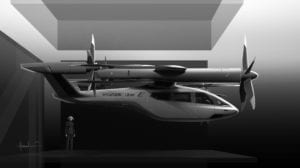Uber and Hyundai have announced a partnership to develop Uber Air Taxis for a future aerial ride-share network and unveiled a new full-scale aircraft concept.
Hyundai is the first automotive company to join the Uber Elevate initiative, bringing automotive-scale manufacturing capability and a track record of mass-producing EVs.
The air vehicle concept was created in part through Uber’s NASA-inspired open design process, which publicly releases vehicle design concepts so any company can use them to develop their own air taxi models and engineering technologies.
In this partnership, Hyundai will produce and deploy the air vehicles, and Uber will provide airspace support services, connections to ground transportation, and customer interfaces through an aerial ride share network.
Both parties are collaborating on infrastructure concepts to support take-off and landing for this new class of vehicles.

Jaiwon Shin, head of Hyundai’s Urban Air Mobility (UAM) division, said: “Our vision of urban air mobility will transform the concept of urban transportation.
“We expect UAM to vitalise urban communities and provide more quality time to people.
“We are confident that Uber Elevate is the right partner to make this innovative product readily available to as many customers as possible.”
Hyundai has already worked with Uber Elevate to develop a personal air vehicle (PAV) model, S-A1, that optimises electric vertical take-off and landing (eVTOL) aircraft for aerial ride-sharing purposes.
Hyundai’s S-A1 model is designed for a cruising speed up to 180mph (290km/h), a cruising altitude of around 1,000-2,000ft (300-600m) above ground, and to fly trips up to 60 mile (100 km).
It will be 100% electric, utilising distributed electric propulsion and during peak hours will require about five to seven minutes for recharging.
The aircraft’s distributed electric propulsion will power multiple rotors and propellers around the airframe to increase safety by decreasing any single point of failure.

According to Hyundai, having several, smaller rotors also reduces noise relative to large rotor helicopters with combustion engines.
Furthermore, the model is designed to take off vertically, transition to wing-borne lift in cruise, and then transition back to vertical flight to land.
It will be piloted initially, but over time will become autonomous.
The cabin is designed with four passenger seats, allowing riders to board / disembark easily and avoid the middle seat with enough space for a personal bag or backpack / rider.




